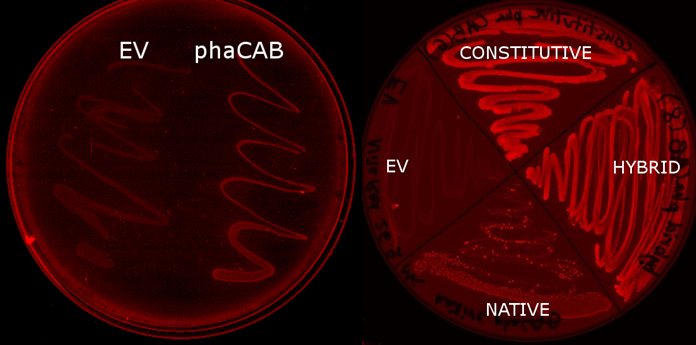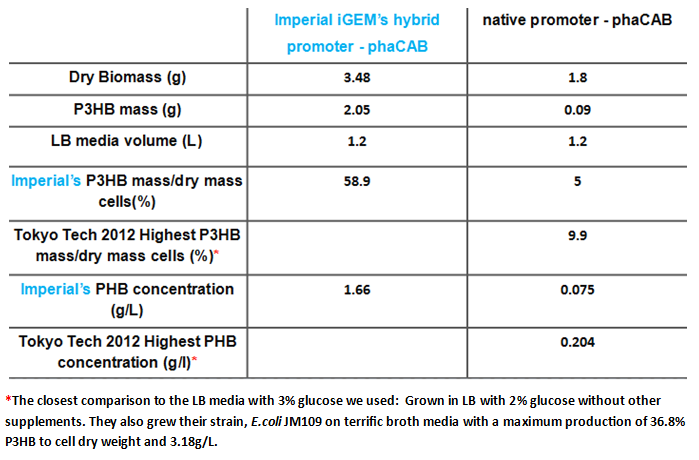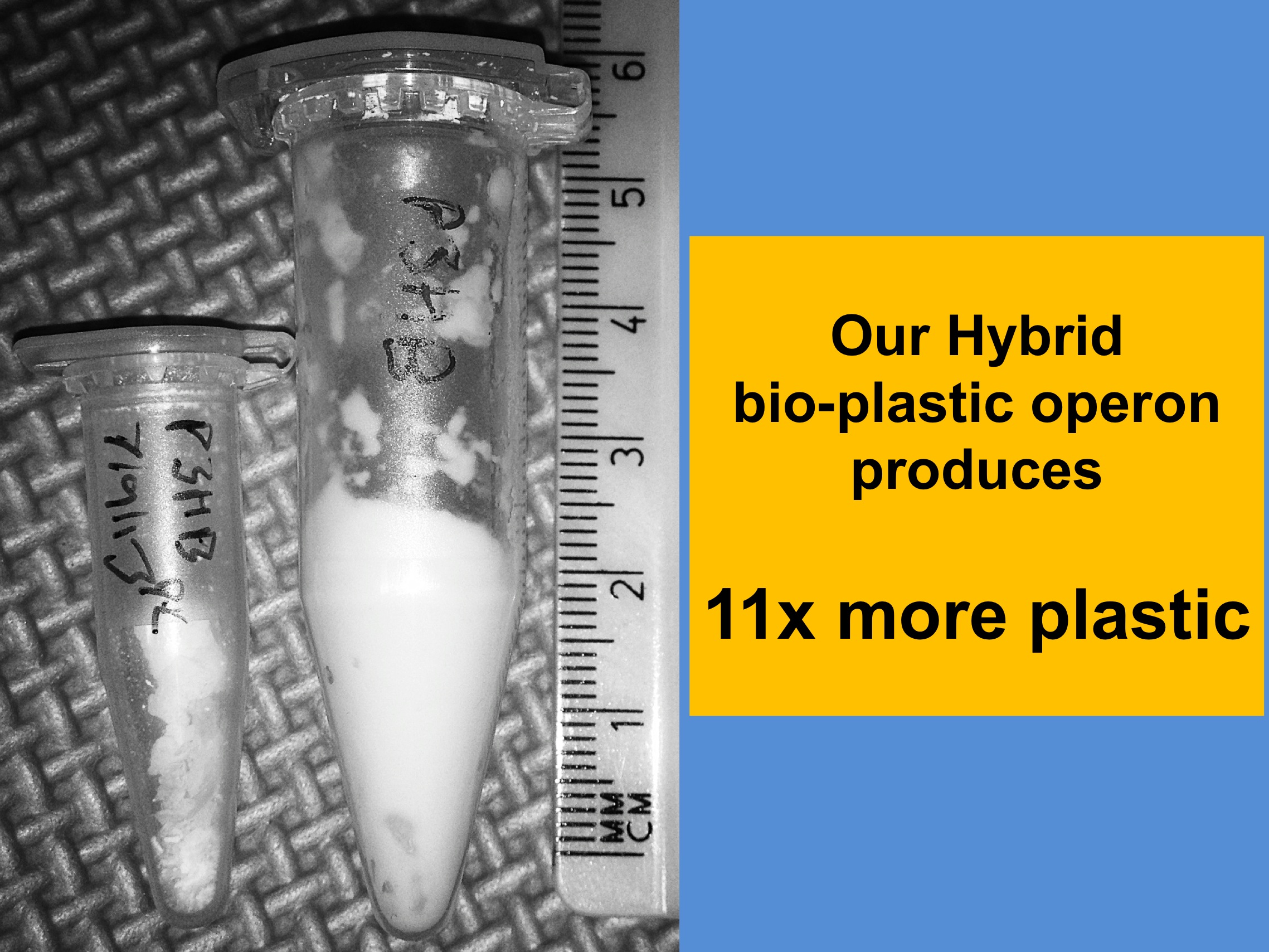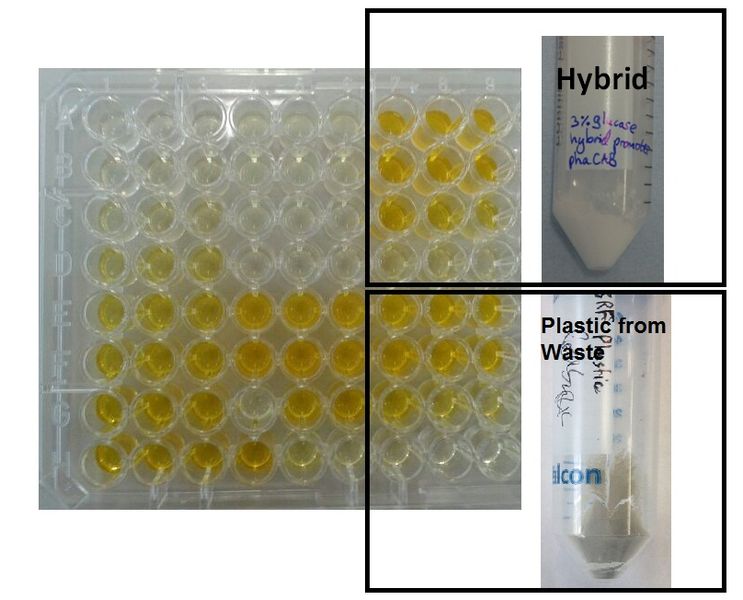Team:Imperial College/mainresults
From 2013.igem.org
| Line 51: | Line 51: | ||
</html> | </html> | ||
| - | <p align="justify">Since our model predicts that the concentration of PhaB enzymes is the rate limiting step in P3HB production, we designed a [http://parts.igem.org/Part:BBa_K1149051 hybrid promoter] consists of the J23104 constitutive promoter and the native promoter to optimise gene expression. Our results show that we have successfully produced <b> | + | <p align="justify">Since our model predicts that the concentration of PhaB enzymes is the rate limiting step in P3HB production, we designed a [http://parts.igem.org/Part:BBa_K1149051 hybrid promoter] consists of the J23104 constitutive promoter and the native promoter to optimise gene expression. Our results show that we have successfully produced <b>11-fold</b> more P3HB bioplastic compared with the native promoter. </p> |
{| class="wikitable" style="margin: 1em auto 1em auto;" | {| class="wikitable" style="margin: 1em auto 1em auto;" | ||
| Line 73: | Line 73: | ||
{| class="wikitable" style="margin: 1em auto 1em auto;" | {| class="wikitable" style="margin: 1em auto 1em auto;" | ||
| - | |[[File:743px-3HB_assay_from_PHB_másolata.jpg|thumbnail|left|600px| | + | |[[File:743px-3HB_assay_from_PHB_másolata.jpg|thumbnail|left|600px| The chemical analysis of the produced bioplastic. The samples break break down to 3HB monomers after treatment with our PhaZ1 enzyme (BBa_K1149010). We synthesised P(3HB) using our improved Biobrick part (hybrid promoter phaCAB, BBa_K1149051). Our engineered bioplastic producing <i>E.coli</i> synthesised P(3HB) directly from waste. Imperial iGEM data]] |
|} | |} | ||
https://static.igem.org/mediawiki/parts/d/d1/3HB_from_PHB_from_waste.jpg | https://static.igem.org/mediawiki/parts/d/d1/3HB_from_PHB_from_waste.jpg | ||
| Line 95: | Line 95: | ||
<div id="CollapsiblePanelM21" class="CollapsiblePanel"> | <div id="CollapsiblePanelM21" class="CollapsiblePanel"> | ||
<div class="CollapsiblePanelTab" tabindex="0"><h5><i>E. coli</i> feeds on 3HB </html><font size="1">▼</font size="1"><html></h5></div> | <div class="CollapsiblePanelTab" tabindex="0"><h5><i>E. coli</i> feeds on 3HB </html><font size="1">▼</font size="1"><html></h5></div> | ||
| - | <div class="CollapsiblePanelContent"> | + | <div class="CollapsiblePanelContent"> |
| + | |||
| + | </html> | ||
| + | |||
| + | |||
| + | |||
| + | <html> | ||
</div> | </div> | ||
| Line 101: | Line 107: | ||
<div id="CollapsiblePanelM22" class="CollapsiblePanel"> | <div id="CollapsiblePanelM22" class="CollapsiblePanel"> | ||
| - | <div class="CollapsiblePanelTab" tabindex="0"><h4>We degraded P3HB </html><font size="1">▼</font size="1"><html></h4></div> | + | <div class="CollapsiblePanelTab" tabindex="0"><h4>We degraded P3HB </html><font size="1">▼</font size="1"><html></h4></div> |
| - | <div class="CollapsiblePanelContent"> | + | <div class="CollapsiblePanelContent"> |
| + | |||
| + | </html> | ||
| + | |||
| + | <p align="justify">Our clearing zone assay indicates that P3HB depolymerase PhaZ1 started to fairly quickly degrade P3HB from the first day. After 3 days, there is evidently a clear zone around the well containing PhaZ1. <b>We are the first iGEM team to degrade bioplastics!</b></p> | ||
| + | |||
| + | [[File:Imperial_clearing_zone.jpg|thumbnail|centre|950px|<font size="2.7">PhaZ1 showing P3HB degradation ability by generating a clear zone on a P3HB LB agar plate. A. No difference between empty vector cell lysate and PhaZ1 cell lysate right after they were pipetted into the wells. B. PhaZ1 in the cell lysate started to clear P3HB around the well after 1 day. C. PhaZ1 created a clear zone around the well after 3 days, whereas it was still cloudy around the empty vector cell lysate well.]] | ||
| + | |||
| + | <html> | ||
</div> | </div> | ||
| Line 108: | Line 122: | ||
<div id="CollapsiblePanelM23" class="CollapsiblePanel"> | <div id="CollapsiblePanelM23" class="CollapsiblePanel"> | ||
| - | <div class="CollapsiblePanelTab" tabindex="0">< | + | <div class="CollapsiblePanelTab" tabindex="0"><h4>We degraded P3HB we made from waste </html><font size="1">▼</font size="1"><html></h4></div> |
| - | <div class="CollapsiblePanelContent"> | + | <div class="CollapsiblePanelContent"> |
| + | </html> | ||
| + | |||
| + | <p align="justify">Using [https://www.caymanchem.com/app/template/Product.vm/catalog/700190 3HB colourimetric assay kit], we have shown that we have degraded the P3HB made from waste into 3HB monomers. In addition, there is no significant difference in 3HB concentration between different P3HB sources. This result proves that <b>we now have a complete P3HB bioplastic recycling lifecycle!</b></p> | ||
| + | |||
| + | |||
| + | <html> | ||
</div> | </div> | ||
</div> | </div> | ||
| Line 136: | Line 156: | ||
var CollapsiblePanelM21 = new Spry.Widget.CollapsiblePanel("CollapsiblePanelM21", {contentIsOpen:false}); | var CollapsiblePanelM21 = new Spry.Widget.CollapsiblePanel("CollapsiblePanelM21", {contentIsOpen:false}); | ||
| - | var CollapsiblePanelM22 = new Spry.Widget.CollapsiblePanel("CollapsiblePanelM22", { | + | var CollapsiblePanelM22 = new Spry.Widget.CollapsiblePanel("CollapsiblePanelM22", {contentIsOpen:false}); |
| - | var CollapsiblePanelM23 = new Spry.Widget.CollapsiblePanel("CollapsiblePanelM23", { | + | var CollapsiblePanelM23 = new Spry.Widget.CollapsiblePanel("CollapsiblePanelM23", {contentIsClose:false}); |
var CollapsiblePanelM24 = new Spry.Widget.CollapsiblePanel("CollapsiblePanelM24", {contentIsClose:false}); | var CollapsiblePanelM24 = new Spry.Widget.CollapsiblePanel("CollapsiblePanelM24", {contentIsClose:false}); | ||
Revision as of 17:34, 4 October 2013
Main Results
Resource-full Waste
Plastic Fantastic
We made P3HB bioplastic ▼
We used E. coli that expresses PhaCAB enzymes to make P3HB bioplastic. This is tested on nile red plates which stains P3HB.
Modelling ▼
Using model simulation results, we predict that the concentration of PhaCAB enzymes
We optimised bioplastic production ▼
Since our model predicts that the concentration of PhaB enzymes is the rate limiting step in P3HB production, we designed a [http://parts.igem.org/Part:BBa_K1149051 hybrid promoter] consists of the J23104 constitutive promoter and the native promoter to optimise gene expression. Our results show that we have successfully produced 11-fold more P3HB bioplastic compared with the native promoter.
We made bioplastic from mixed waste ▼
One of the objectives of Module 1 is to produce P3HB bioplastic from waste. By comparing degradation product 3HB of P3HB bought from Sigma, produced from glucose and produced from the waste, we found there is no significant differences in 3HB concentration between these samples.

E. coli feeds on 3HB ▼
We degraded P3HB ▼
Our clearing zone assay indicates that P3HB depolymerase PhaZ1 started to fairly quickly degrade P3HB from the first day. After 3 days, there is evidently a clear zone around the well containing PhaZ1. We are the first iGEM team to degrade bioplastics!
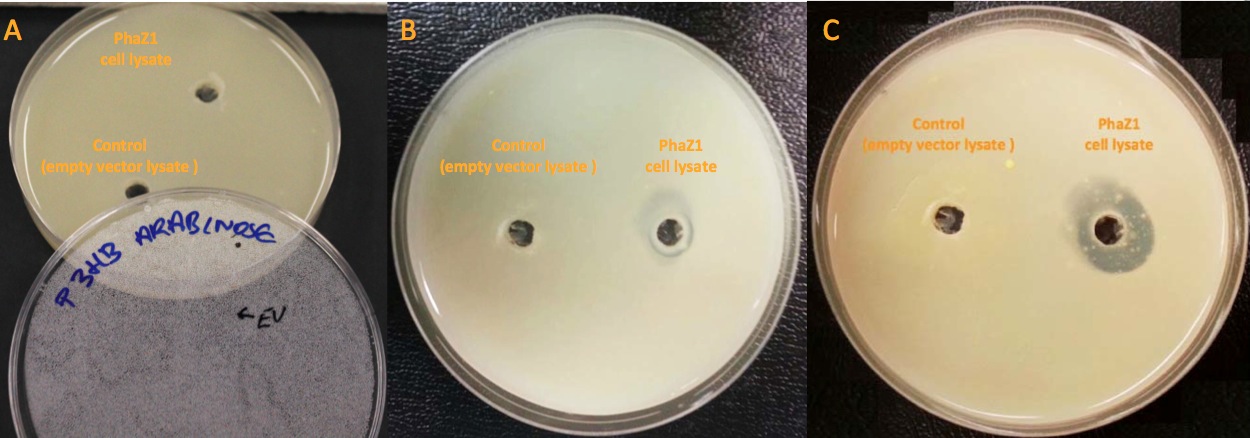
We degraded P3HB we made from waste ▼
Using 3HB colourimetric assay kit, we have shown that we have degraded the P3HB made from waste into 3HB monomers. In addition, there is no significant difference in 3HB concentration between different P3HB sources. This result proves that we now have a complete P3HB bioplastic recycling lifecycle!
We degraded PLA ▼
 "
"




